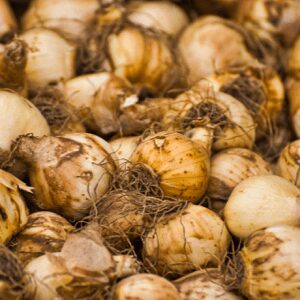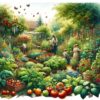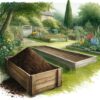The Ultimate September Gardening Checklist: Your Comprehensive Guide to Preparing for the Fall Season
September is a critical turning point for gardeners. The transition between seasons presents a unique set of challenges and opportunities. Whether you’re relishing the final days of summer or eagerly anticipating the colors of fall, there’s plenty of work to be done in your garden to set the stage for a successful growing year ahead. This September gardening checklist offers a detailed breakdown of the essential tasks that can help you get the most out of your garden during this pivotal month.
Harvesting Late-Summer Crops
Why It’s Important
Late-summer crops such as tomatoes, peppers, and zucchinis reach peak ripeness during September. Harvesting these crops not only offers you a bounty of fresh produce but also clears the way for upcoming fall crops.
How to Do It
Look for signs of maturity like color, firmness, and size. It’s also essential to harvest during the coolest part of the day to ensure freshness. Once harvested, store these vegetables correctly to prolong their shelf life.
Pro Tips
- Use clean, sharp tools for harvesting to minimize damage.
- Some crops, like tomatoes, continue to ripen off the vine.
Planting Fall Crops
Why It’s Crucial
September is the ideal time to start your fall garden. As temperatures begin to drop, crops like kale, radishes, and Swiss chard become easier to manage and often taste better when grown in cooler weather.
How to Do It
- Research your USDA Hardiness Zone to identify the most suitable crops for your location.
- Prepare the garden beds by removing any remaining summer crops and weeds.
- Plant seeds or transplants as recommended by local planting guidelines.
Pro Tips
- Keep an eye on soil moisture. Cooler temperatures can be deceptive; your plants still need regular watering.
- Consider using row covers to extend the growing season.
Preparing Garden Beds
Why It’s Necessary
Any September Gardening Checklist would be remiss if we did not discuss soil preparation. The health of your garden is directly tied to the quality of its soil. September is the perfect time to prepare your garden beds for fall planting and set the stage for next spring.
How to Do It
- Remove weeds and any leftover summer crops.
- Turn over the soil and add a generous layer of compost.
- Conduct a soil test to check nutrient levels.
Pro Tips
- If you have perennial beds, be cautious while turning the soil to avoid damaging the root systems.
- Organic matter like well-rotted manure or garden compost is excellent for improving soil structure.
Mulching Around Perennials
Why It Matters
Mulching helps to conserve soil moisture, suppress weeds, and improve soil quality, making it an essential task for September gardening.
How to Do It
- Choose a suitable mulch material such as straw, bark, or leaves.
- Apply a 2-3 inch layer of mulch around the base of your perennial plants.
Pro Tips
- Avoid piling mulch against the stem of plants to prevent rot and pest infestation.
- Organic mulches break down over time, enriching your soil in the process.
Pruning Dead or Diseased Limbs
Why It’s Essential
Pruning helps manage plant diseases and encourages better growth patterns. Late summer and early fall are the best times to prune non-flowering shrubs and trees.
How to Do It
- Identify dead or diseased branches.
- Use sharp pruning shears to make clean cuts.
Pro Tips
- Always cut at a 45-degree angle, just above a bud, to encourage new growth.
- Sterilize your tools between cuts, especially if you’re dealing with diseased plants.
Collecting Seeds and Cuttings
Why It’s Beneficial
Collecting seeds and taking cuttings can save you money and help propagate your favorite plants for the next growing season.
How to Do It
- For seeds, choose from the healthiest and most robust plants in your garden.
- For cuttings, look for healthy, disease-free stems.
Pro Tips
- Store seeds in a cool, dry place until you’re ready to plant.
- Root cuttings in a mixture of sand and peat moss for the best results.
Pest and Disease Control
Why It’s Necessary
Although cooler weather can reduce pest activity, vigilance is key. Neglected infestations can survive the winter and return stronger in the spring.
How to Do It
- Regularly inspect your plants for signs of pests or diseases.
- Use natural solutions like neem oil or insecticidal soap as preventative measures.
Pro Tips
- Early morning or late afternoon is the best time to apply natural pesticides, as beneficial insects are less active during these times.
Lawn Care
Why It’s Crucial
September is a vital month for lawn maintenance. It sets the foundation for a lush, healthy lawn in the year ahead.
How to Do It
- Aerate your lawn to improve soil structure and nutrient absorption.
- Fertilize using a high-phosphorus mix to encourage strong root development.
- Over-seed sparse areas to develop a thick, robust lawn.
Pro Tips
- Water the lawn deeply a day or two before aerating for best results.
- Keep foot traffic to a minimum after seeding until the new grass is at least 2 inches high.
Winterizing Garden Tools
Why It’s Important
Proper maintenance of your garden tools ensures their longevity and effectiveness, saving you money in the long run.
How to Do It
- Clean soil and plant debris from your tools.
- Sharpen blades and oil moving parts.
Pro Tips
- Store tools in a dry, protected place over the winter months.
- Regular maintenance can prevent rust and mechanical issues.
Planning for Spring Bulbs
Why It’s Wise
Planning and purchasing your spring bulbs in September ensures that you’re ready for planting in October and November, leading to stunning spring blooms.
How to Do It
- Order bulbs like tulips, daffodils, and hyacinths from reputable suppliers.
- Choose a well-drained location
Additional Fall Checklist Tips and Tricks
Fertilizing Perennials and Shrubs
Why It’s Advantageous
The end of the growing season is a great time to give your perennials and shrubs a nutrient boost, ensuring they have the energy reserves needed to make it through the winter and emerge stronger in the spring.
How to Do It
- Apply a balanced fertilizer to the soil around the base of the plants. Read more on how to fertilize.
Pro Tips
- Avoid applying fertilizer directly onto the plant leaves as this can cause burns.
Watering Strategies
Why It’s Essential
While the weather is cooling down, plants can still experience stress from fluctuating temperatures and moisture levels.
How to Do It
- Continue to water your garden as necessary, paying attention to the specific needs of newly planted fall crops.
Pro Tips
- Consider installing a drip irrigation system for consistent moisture, particularly if you live in a region with water restrictions.
Installing Protective Covers and Netting
Why It’s Useful
Protecting vulnerable plants from early frosts or pests can extend your growing season and improve yields.
How to Do It
- Use frost blankets or protective netting to cover sensitive plants as temperatures drop.
Pro Tips
- Keep an eye on weather forecasts and have your covers ready to deploy quickly.
Setting Up Compost for Fall
Why It Matters
The bounty of fall leaves and spent summer crops can be turned into valuable compost for next year’s garden.
How to Do It
- Set up a compost bin or pile, layering greens (like vegetable scraps) and browns (like dried leaves).
Pro Tips
- Turn the compost regularly to expedite the decomposition process.
Planning and Record-Keeping
Why It’s Beneficial
Keeping track of what worked and what didn’t during the past growing season provides valuable insights for future planning. See our post on garden journaling.
How to Do It
- Maintain a gardening journal or use a gardening app to document your experiences, planting dates, and harvest yields.
Pro Tips
- Include photos to help visually remind you of your garden layout, successful crops, or problem areas that need attention next season.
Preparing Indoor Plants for Winter
Why It’s Necessary
Many gardeners overlook their indoor plants when preparing for the fall season, but these plants also need adjustments to adapt to changing light and temperature conditions.
How to Do It
- Gradually reduce watering and withhold fertilizer as indoor plants enter their slower winter growth phase.
Pro Tips
- Make sure to inspect indoor plants for pests before bringing them inside, as they can become a haven for outdoor pests seeking winter shelter.
Conclusion: Your September Gardening Roadmap
September is a crucial month for gardeners; it’s a time for both reflection and action. It’s a period to reap the rewards of the summer season while also setting the stage for a successful fall and spring ahead. With tasks ranging from harvesting summer crops and planting fall greens, to winterizing your tools and planning for spring blooms, there’s no shortage of work to be done.
This comprehensive September gardening checklist aims to be your go-to guide for navigating this transitionary month. Whether you’re a seasoned gardener or a newbie looking to gain some experience, these tips and tasks can make your September gardening not only productive but also immensely rewarding. Here’s to a fruitful fall season and an equally promising year ahead in the garden!
Tags: #SeptemberGardening #GardeningChecklist #FallSeason #GardeningTips #GardenPreparation #LawnCare #WinterizeGardenTools #SoilHealth #PerennialCare #HarvestCrops #PlantBulbs #Fertilizing #Watering #Composting #Planning #RecordKeeping
If you found this guide helpful, please consider sharing it with fellow gardening aficionados. Your garden will thank you, and so will theirs. Happy gardening!













You must be logged in to post a comment.